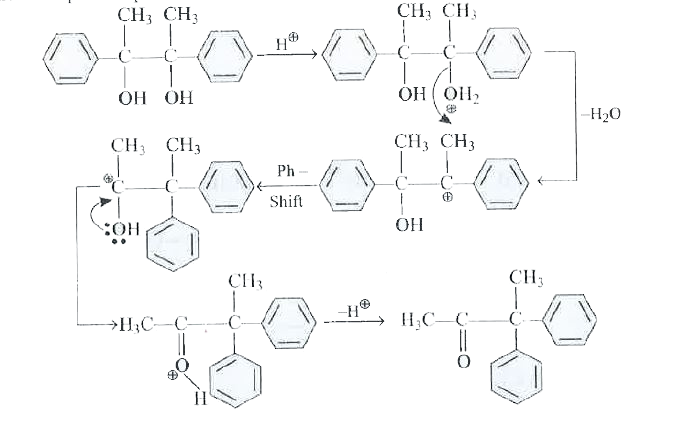Pinacol Rearrangement.
Completely substituted 1,2-diols such as 2, 3-dimethyl-2, 3-butanediol, are known as pinacols. They undergo dehydration and rearrangement in acid to form ketones.
This reaction is called pinacol rearrangement, e.g.
CH3−CH3∣C∣OH−CH3∣C∣OH−CH3PinacalH+−−→CH3−C∣∣O−CH3∣C∣CH3−CH3Pinacolone+H2O
Topper's Solved these Questions
Similar Questions
Knowledge Check
- Question 1 - Select One or More
Di-tert-glycols rearrange in the presence of acid to give alpa-tertiary ketones. The trivial name of the simplest glycol of this type is pinacol, and this type of reaction therefore is named pinacol rearrangement (in this specific case, the reaction is called a pinacol-pinacolone rearrangement). The rearrangement involves 4 steps. one of the hydroxyl groups is protonated in the first step. A molecule of water is eliminated in the second step and a tertiary carbocation is formed. The carbocation rearranges in the third step into a more stable carboxonium ion via a [1,2] rearrangement. In the last step, the carboxonium ion is deprotonated and the product ketone is obtained.

What is R.D.S. of pinacol-pinacolone rearrangement?AI stepBII stepCIII stepDIV step - Question 2 - Select One
Di-tert-glycols rearrange in the presence of acid to give alpa-tertiary ketones. The trivial name of the simplest glycol of this type is pinacol, and this type of reaction therefore is named pinacol rearrangement (in this specific case, the reaction is called a pinacol-pinacolone rearrangement). The rearrangement involves 4 steps. one of the hydroxyl groups is protonated in the first step. A molecule of water is eliminated in the second step and a tertiary carbocation is formed. The carbocation rearranges in the third step into a more stable carboxonium ion via a [1,2] rearrangement. In the last step, the carboxonium ion is deprotonated and the product ketone is obtained.


How many products obtained in above reaction?A1B2C3D4 - Question 3 - Select One
Di-tert-glycols rearrange in the presence of acid to give alpa-tertiary ketones. The trivial name of the simplest glycol of this type is pinacol, and this type of reaction therefore is named pinacol rearrangement (in this specific case, the reaction is called a pinacol-pinacolone rearrangement). The rearrangement involves 4 steps. one of the hydroxyl groups is protonated in the first step. A molecule of water is eliminated in the second step and a tertiary carbocation is formed. The carbocation rearranges in the third step into a more stable carboxonium ion via a [1,2] rearrangement. In the last step, the carboxonium ion is deprotonated and the product ketone is obtained.

 A
A B
B C
C D
D
Wolff rearrangement
View SolutionDi-tert-glycols rearrange in the presence of acid to give alpa-tertiary ketones. The trivial name of the simplest glycol of this type is pinacol, and this type of reaction therefore is named pinacol rearrangement (in this specific case, the reaction is called a pinacol-pinacolone rearrangement). The rearrangement involves 4 steps. one of the hydroxyl groups is protonated in the first step. A molecule of water is eliminated in the second step and a tertiary carbocation is formed. The carbocation rearranges in the third step into a more stable carboxonium ion via a [1,2] rearrangement. In the last step, the carboxonium ion is deprotonated and the product ketone is obtained.

 View Solution
View SolutionAcid catalysed conversion of 1,2-diol or vicinal diol, into carbonyl compound known as pinacol-pinacolone rearrangement.

Generally more electron donating group migrate during mechanism, migration of -H is faster because of its smaller size.

Which of the following is not correct about this rearrangemet?View SolutionAcid catalysed conversion of 1,2-diol or vicinal diol, into carbonyl compound known as pinacol-pinacolone rearrangement.

Generally more electron donating group migrate during mechanism, migration of -H is faster because of its smaller size.

What would be the major product of reaction?View SolutionAcid catalysed conversion of 1,2-diol or vicinal diol, into carbonyl compound known as pinacol-pinacolone rearrangement.

Generally more electron donating group migrate during mechanism, migration of -H is faster because of its smaller size.


In this sequence of reaction final product is :View Solution

